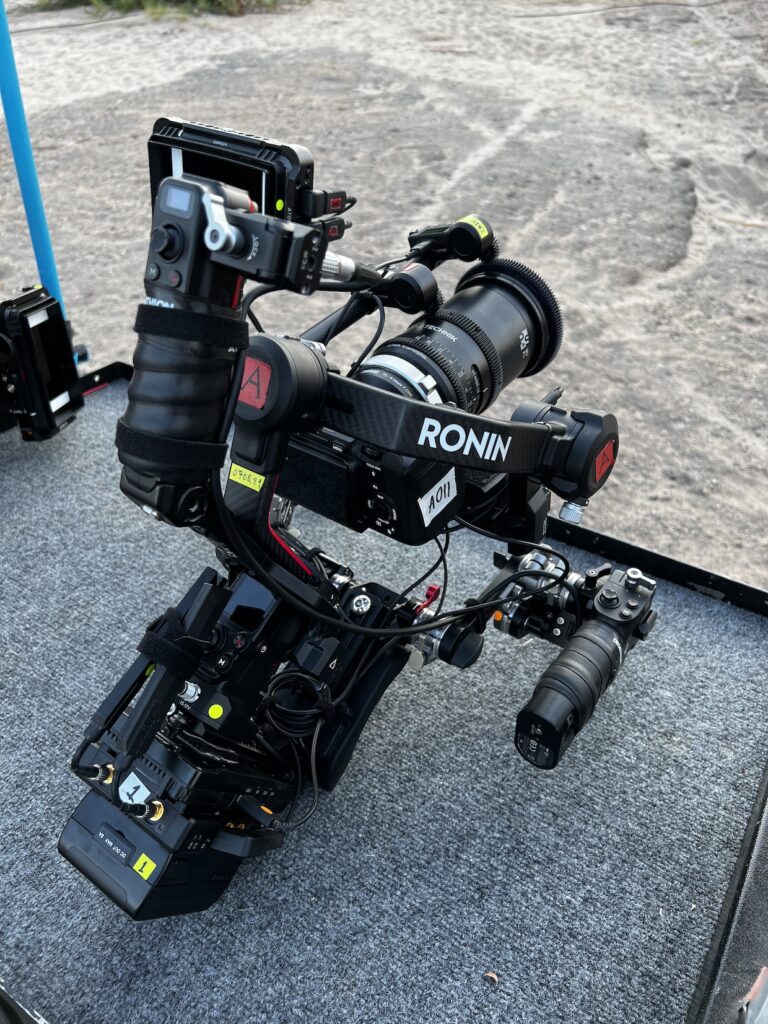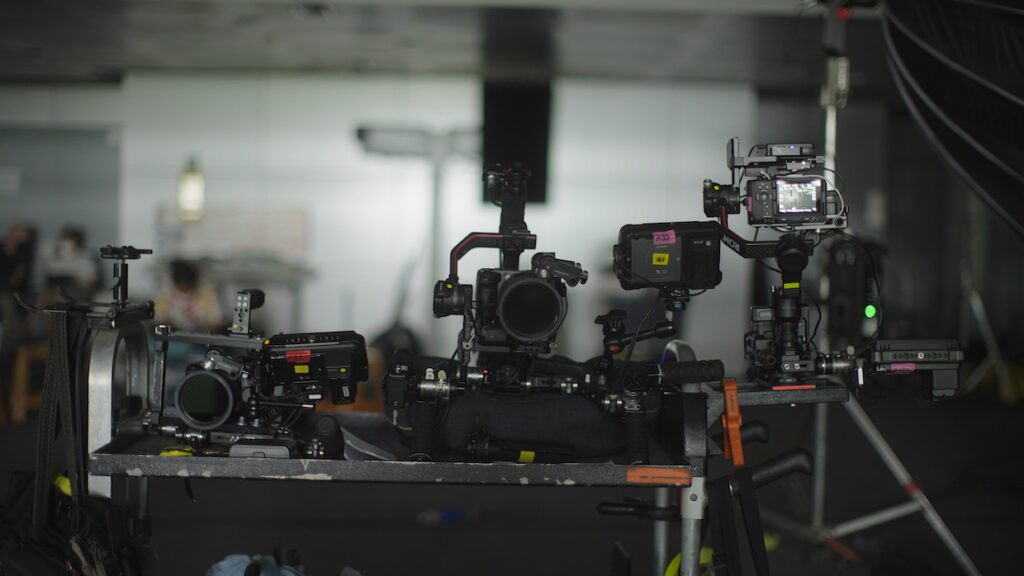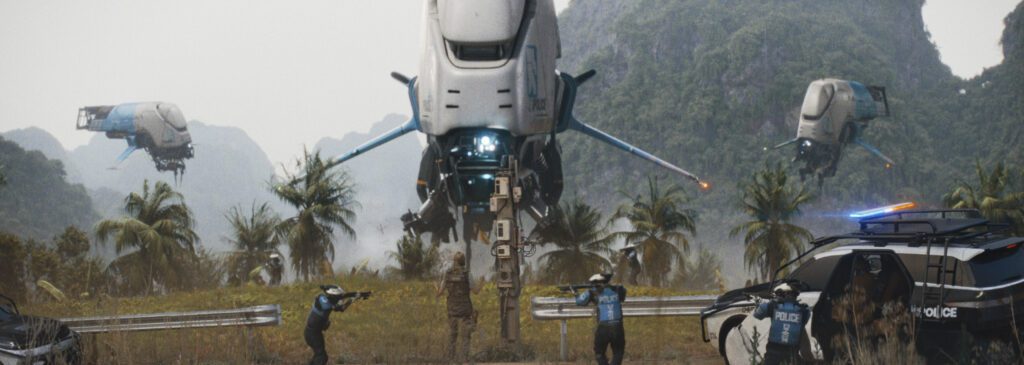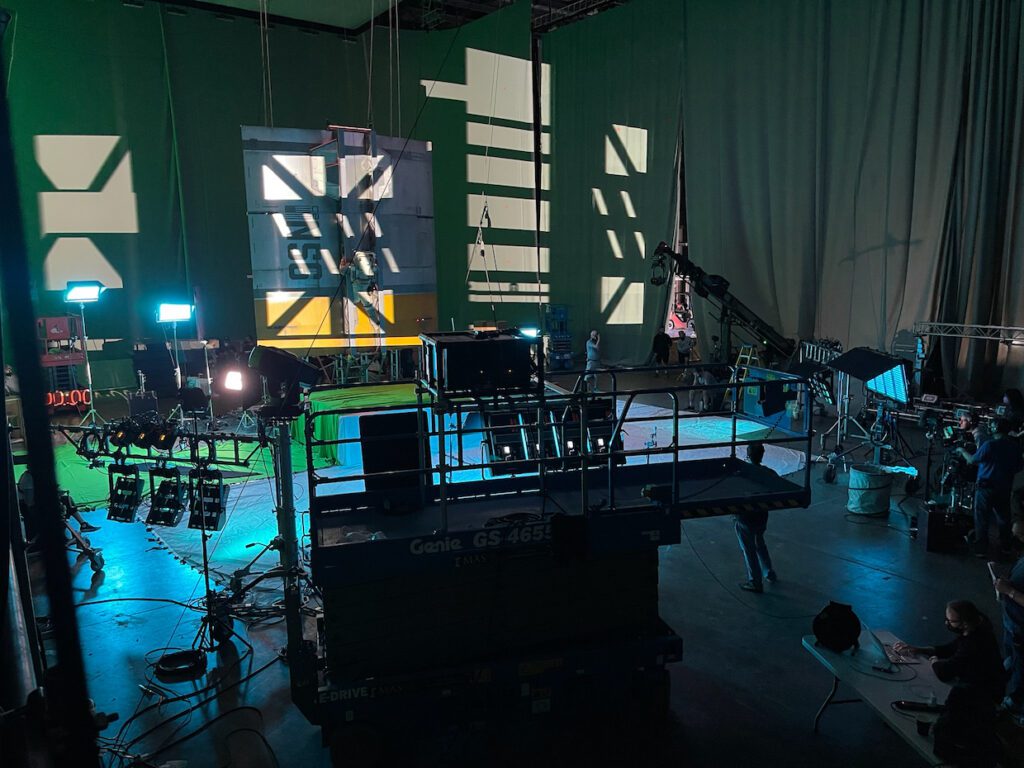 Back to selection
Back to selection
Shutter Angles
Conversations with DPs, directors and below-the-line crew by Matt Mulcahey
The Focus Pulling Olympics: DP Oren Soffer on The Creator
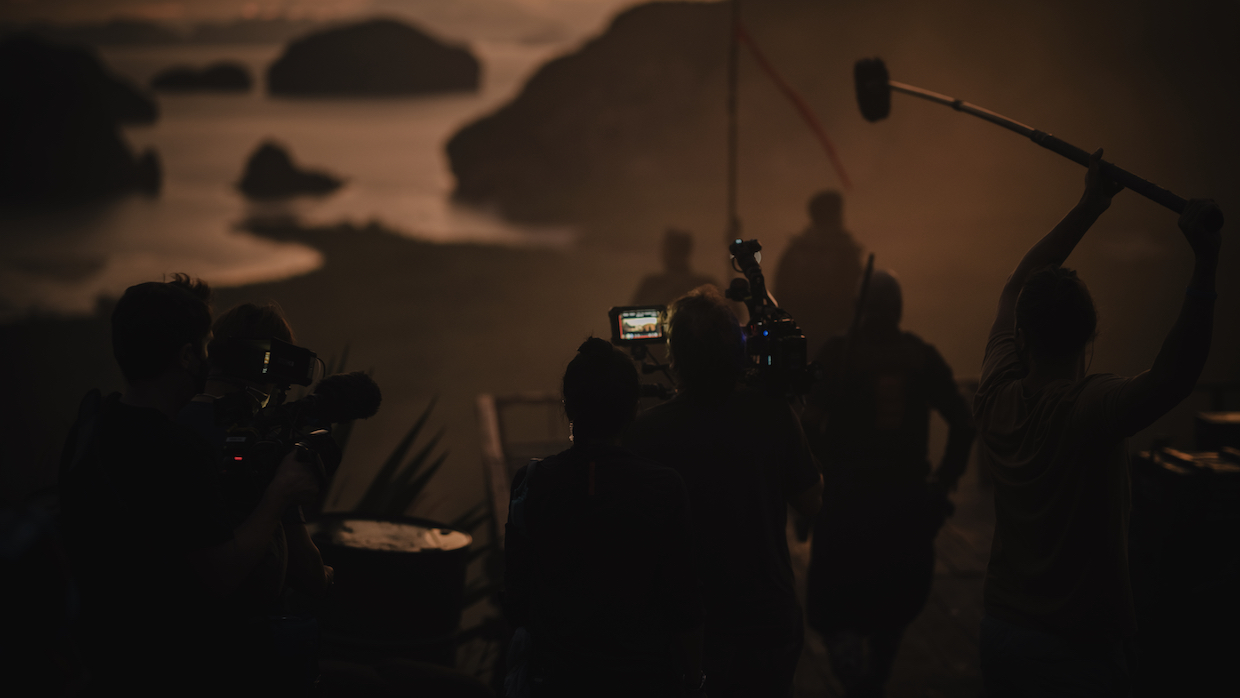 On the set of The Creator
On the set of The Creator On big budget spectacles, the tail of VFX often wags the dog of principal photography. With The Creator—an $80 million sci-fi epic about a war between mankind and humanoid AI starring John David Washington—director Gareth Edwards sought to reverse that arrangement.
The Monsters and Rogue One filmmaker has described the process of meticulously recreating previs on set as painting a target on the wall and trying to fire an arrow into the bullseye. With The Creator, Edwards wanted to fire the arrow first, then paint the target around it, with VFX ideation occurring later in the pipeline after being inspired by the Thailand-based location photography.
For his archers, Edwards enlisted Oren Soffer and Dune Oscar-winner Greig Fraser as co-cinematographers. Their quiver of arrows was an astonishingly thrifty one. The $4,000 prosumer Sony FX3 served as the main camera, with 95 percent of the film shot on 75mm Kowa anamorphic lenses. A 42mm prototype Atlas Mercury anamorphic was carried for situations requiring a wider focal length and IronGlass rehoused vintage Soviet still lenses were occasionally trotted out for drone work or visual effects plates. For camera platforms, inexpensive Kessler dollies and scissor cranes were employed. The lighting package was dominated by budget friendly Aputure LED units.
With the movie out now in theaters, Soffer spoke to Filmmaker about holding a “focus-puller Olympics,” shooting at 12,800 ISO and how, if Edwards had his way, you’d be watching The Creator in an ultra wide 3.5:1 aspect ratio.
Filmmaker: I don’t want to spend too much time on this because it’s been covered at length elsewhere, but basically the way you came to work on the film is that Greig Fraser’s schedule shifted for Dune: Part Two, so he wasn’t able to go to Thailand for principal photography. He suggested you as his replacement on set. Once you came onboard, you had four months with Gareth to get ready while Greig contributed remotely.
Soffer: We had almost daily Zoom meetings with Greig, but most of those four months of prep were Gareth and I and some of the rest of the production team on the road in Thailand and Cambodia, or just prepping at our production office and shooting a ton of tests. One of the luxuries of the equipment we chose was we were able to buy the cameras and the lenses. So, we had a four-month period where we had all the gear. We were able to take the camera, our lenses and some of the lights with us on all the scouts and would shoot footage that ended up in a little reel we used to create our show LUT. We also captured some docu-style texture shots on the scout, a few of which ended up in the movie.
Filmmaker: Had Greig and Gareth already decided on the FX3 when you came aboard?
Soffer: Yes, and I think I had the same initial reaction that everybody else had: “Really?” But that was just because I knew nothing about that camera yet. Greig shot a couple of commercials with our specific lens and camera combination earlier in the year to test run it in the field. So, I went to FotoKem with Greig and our colorist Dave Cole and looked at their test footage, and I looked at those commercials, and it was instantaneous: “The camera can do that! I get it now.” Once you open that lid and realize that this camera can actually shoot 4K RAW with 15 stops of dynamic range, you understand how capable it is ]of handling a shoot like ours].
Filmmaker: The small form factor was a selling point—the body of that thing weighs literally a pound—but there are other cameras of similar size. What were the other draws of the FX3?
Soffer: What’s unique about that camera compared to others in that similar range is that Sony basically took the color science from the Venice and put it into this $4,000 camera. You’re getting pretty much the same color information and fidelity out of that little package that you would get out of the bigger cameras. The camera did have limitations. It’s missing a lot of the cinema-forward internal design decisions of something like the Venice. Sony menus are infamous for being a little labyrinthine when you’re trying to find the settings you’re looking for. The Venice simplified those menus, but the FX3 doesn’t have those simplifications. The high speed is quite limited., shutter angle control is quite limited. So, there were compromises, but we were able to work around them. We didn’t need slow motion. We also don’t really like manipulating the shutter angle. I think Greig, Gareth and I all share that we like approaching cinematography from the simplest possible angle, and we like to strip away as many complexities as we can. It’s why none of us really like using filters except for ND. It’s why we shot the movie almost entirely on one lens.
Filmmaker: Did you have any issues with those cameras overheating?
Soffer: We had 10 camera bodies because we definitely thought we might, but, surprisingly, we didn’t run into any issues with that. Maybe it was just because we kept switching between the camera bodies, so we were never really rolling on one camera for more than 25 or 30 minutes at a time. When we would finish a shot on one rig, we would usually switch to another. Let’s say we did a 30-minute take on our gimbal. That would then be put away and we would do another shot on the crane, which had a different camera body already rigged on it. Once that shot was done, we would fly the drone and that was a different camera body.
Filmmaker: So, the different camera platforms were each pre-rigged with their own FX3 so you could jump between them without set-up time?
Soffer: Yes, that was the advantage of shooting with this system—we were able to buy 10 camera bodies and pre-rig them in different ways. On set, it looked like a camera buffet. There’s a great shot from the documentary footage by Glen Milner [pictured above] that has all the cameras laid out on the cart all ready to go. You could just grab whichever one you wanted. We had a handheld rig without a gimbal for old school shoulder-mounted shots. We had a rig for the dolly and another for the crane. We had one for the drone. We also had a rig we called “the holiday rig,” because it’s the type of camera build you would take on holiday. It was designed to just be picked up and shot by one person. It didn’t have any follow focus on it. It didn’t have wireless video, no attachments at all except a Ninja recorder sitting on top of the camera on the hot shoe mount. It was pretty much just the camera body and a lens. We could carry that around with us and, if we were driving to location and there was a great shot out the window of the van, we would grab it. That was also the main rig that we used on our location scouts. For four months we literally carried that camera around everywhere—on the plane, in the vans. It was always there.
Filmmaker: Sometimes I’ll hear about a music video or commercial that brags about shooting on a low-cost camera, but then when I watch the “making of” for the project they’re using expensive lenses and high-end camera movement platforms. You went with budget-friendly options all around – a Ronin RS2 gimbal for when Gareth operated, a scissor crane, a Kessler dolly with some sort of metallic silver jib on it.
Soffer: That’s exactly right. The small footprint approach extended to every facet of camera, lighting and grip. We had a small grip and electric team—each was five people. The whole thing was designed to be as nimble as possible. The idea behind that little Kessler dolly was that we wanted a dolly that we could physically carry with us. Sometimes we’d have to hike a half mile to get to the shooting location or ride in a stake bed truck that was bouncing precariously on some rocks. You’re not going to take a Chapman dolly with you for that. You’re not going to take a Technocrane to those kinds of locations, but you can take that little Kessler dolly and that scissor crane. Those are really portable and quick to set up. The goal was that it should not take more than five minutes to set up a dolly shot, and the grip team always rose to that challenge. We paired that dolly with a GF-Mini Jib—that’s the one you mentioned—just for flexibility. We could rough in the track placement, then the jib gave us the flexibility to fish a little bit for the exact angle.
Filmmaker: Did you seek out those particular tools or were they just things the rental house had?
Soffer: That gear was already in place by the time I came on board the project. It was probably stuff that Greig and Gareth saw at Cine Gear or that Gareth found just by searching on B&H. Production sold all the gear at the end, so they even made some of their money back.
The thing with rental houses, especially in Thailand, is that the minute you rent a truck it comes with crew. So, the minute you have a five-ton grip truck show up, four guys show up with it, and we really wanted to keep the footprint small. So, we designed the shoot in a way where we would buy everything we could, then we would day play additional gear on specific days if we needed to expand the footprint. There were some night exteriors where we did have additional crew and we had some additional lights and lifts and everything. For some of the days we shot on stage in Thailand we needed a more traditional lighting and grip package, so we partnered with a local rental house. For our London shoot we partnered with MBS, who provide equipment at Pinewood. It was a little surreal coming off our scrappy Thailand shoot and going to Pinewood. You’d walk onto stage and there would just be cart after cart after cart of hundreds of Creamsource Vortexes. We got to play in that sandbox for two weeks, which was fun.
Filmmaker: The London portion of the shoot included some StageCraft work on an LED volume and Greig was there for that. I can’t tell you how many people I’ve interviewed who have said that Greig hopped on a call with them to talk about virtual production. He’s like the Volume Godfather.
Soffer: He kind of is. We all reconvened in London at the end of the shoot for two weeks. Half of it was Stagecraft, and half of it was a traditional soundstage shoot with gray screens and partial set builds.
Filmmaker: Had you worked on a Volume stage before?
Soffer: It was my first time. I thought the process was really cool, but we were very deliberate about what scenes were shot on there. It was narrowed down to what would really benefit from the interactive lighting that you get from StageCraft and what were locations that we couldn’t find in the world. Certain things in the third act don’t really exist—there was no “real world” place to go get that look.
We did end up replacing a lot of the Volume backgrounds in the wide shots, which I think is not unusual. The illusion breaks the minute you get wide enough to start seeing things like where the wall connects to the ceiling, but even if you replace those backgrounds, you’re still getting the benefit of the environmental lighting and the framing. Also, 95 percent of the design work has already been done, so when you ask ILM later to replace that background, they’re just swapping it with a nicer version of what was already on the LED wall, as opposed to building something from scratch. But I think to Greig—and I’ve definitely been influenced by him in this regard—[getting in-camera finals] is really the secondary component of shooting on the volume. The more important aspect of it is using it as a lighting tool and using it to create environmental lighting the same way that you would on a location.
Filmmaker: When I spoke to Greig for Dune, he was just getting into this film out/scan back process that he also later used on The Batman. Was there any discussion about doing that on The Creator?
Soffer: We were planning on doing it, actually. FotoKem really pioneered that process, and we were working with them and with colorist Dave Cole, who also did Dune and The Batman. So, we were planning on it and tested it, but ended up not doing it because it would’ve required too much time to go in and finesse it. The only disadvantage of doing that process is that it’s like a one light. You finish your grade, then print and re-scan your entire finished film, so you’re getting one equal pass across the whole movie of whatever you added—the grain, halation and other elements that come out of that process. On Dune and The Batman, especially because of the COVID delays, they had extra time in the grade to go in shot-by-shot and decide how much of the scan back to use and how much to put a little opacity on it to soften the effect and reveal a little bit of the original grade underneath. It’s a meticulous process and, to be honest, we ran out of time on the color grade. So, we added the film grain and halation and all that digitally using FotoKem’s proprietary film emulation tools. They look good and doing it that way gave us the flexibility to adjust the amount of the effect on a scene-by-scene basis [more easily than with the scan back process]. Some scenes were inherently noisier than others, so they needed less film grain added. The day exterior scenes maybe needed a bit of a heavier film look applied to them, whereas some of our darker night interiors shot at 12,800 ISO already had a nice noise to them and we didn’t need to add much grain on top of it.
Filmmaker: What was your camera department like?
Soffer: Our camera team was all local. Our 1st AC, Krittabhat “Aey” Khieolek, was a genius. There’s a funny story there. Gareth actually auditioned focus pullers. He was like, “We need to find the best focus puller in Thailand.” We knew there were going to be no marks, no traditional rehearsals. There were blocking rehearsals, but we weren’t going to rehearse shots on camera. We were going to intuit and feel our way through the coverage, so we needed someone who could roll with that while shooting wide open on anamorphics in full frame. So, we set up an audition and brought in like the three best focus pullers in Thailand.
Filmmaker: You ran them through drills?
Soffer: It was like the Focus Pulling Olympics. Each AC showed up with their focus gear and monitor and we’d give them some time to familiarize themselves with our camera set-up. Then Gareth would just pick up the camera and start walking around the production office creating shots. He would walk through the aisles of the art department as they were working on props and do little push-ins and pans and the focus pullers were chasing after him, keeping it all sharp on their monitors. Aey just absolutely crushed it. We knew after that test that he could roll with anything. He did an incredible job keeping up with Gareth, as did the grip team. They were all amazing. It was a very fast pace, not the typical pace you’d expect on a film of this size.
Filmmaker: On the lighting end of things, you used a lot of reasonably priced Aputure units.
Soffer: Our main lighting package was Aputure, then we had some Astera tubes and a little battery powered RGB LED Rosco DMG dash light. Those have attachments that you can put on the front, including one that’s dome shaped, which is quite useful. There are actually a few shots in the movie where the Rosco DMG is on camera as a practical. [See the photo above.] There are a lot of shots with Aputure MCs in the frame as practicals. The art department created little housings that you could put different lights inside so that you could shoot them on camera. They had an industrial design to them, but there was a little hatch where you could put a battery powered LED inside of it. We would use those as on-camera practicals all the time. They made some shaped like Helios tubes that we could slip 2’ x 2’ tubes into. Those are all over the movie on camera, because with Gareth operating there was always a chance that you were going to end up with a light in frame, so you might as well have it be shootable and blend in with the set design.
Filmmaker: Greig’s advice to you about Gareth as an operator was basically, “He could look in any direction at any moment.” Tell me about how you adapted your lighting approach for that. You were riding the dimmer board a lot to adjust levels mid-shot, then you had an electric toting an LED basically on a boom pole for on-the-fly tweaks.
Soffer: That was exhilarating. I’ve never worked in live television, but it felt to me like what live TV must be like. Everything that you did and every decision that you made had instantaneous feedback on camera during a take and could end up in the movie. It definitely keeps you on your toes.
Filmmaker: Did you know in preproduction that would be the approach, or did you get on set and have to adapt to Gareth’s operating methods?
Soffer: We knew that was how we were going to shoot the movie. During our location scouts and our test shoots at our production office, we specifically tested that methodology quite a bit. We did multiple test shoots that we would treat as if they were a shoot day. Especially in the final week when we were doing makeup and wardrobe tests with the actors, we would bring everybody in—the sound team, the ADs, SFX, everybody—and practice that methodology. Gareth would set up little scenes between the actors where they would improvise, then we would shoot it. So, we were practicing following Gareth around with the light. Those tests were instrumental for us, because we got the growing pains out of the way before getting to the first shoot day.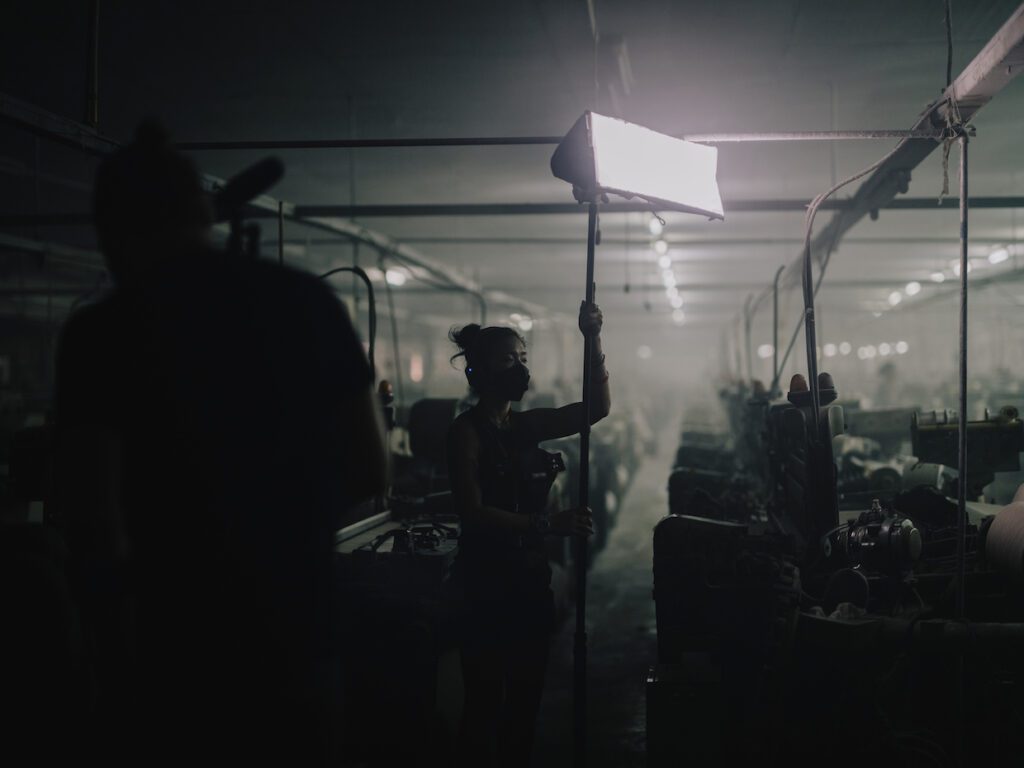
Filmmaker: With that light on the boom pole, did the electric almost have to anticipate where Gareth was going to move and beat him to the spot? You don’t want to see the light moving into the shot.
Soffer: There’s a lot of footage on the cutting room floor where the lighting isn’t perfect. That’s basically the trick behind this [method of working] We would shoot four hours of raw footage a day, which is a high ratio especially for a film like this, but we knew that all we needed was two or three minutes of great footage every day.
It definitely took a minute to figure out the rhythm of the lighting on the boom pole, but once our best electric Nancie Yoo Kang got into that rhythm, she understood the best angles and we wouldn’t need to overcommunicate where she needed to go. It became quite intuitive. Nancie was often pointing the light away from the actor, bouncing it off the floor or wall or something else in the environment. We found during testing that it felt much more believable and less source-y, more like an incidental light in the space as opposed to something we placed. She wore an iPhone on her arm strapped on with some kind of workout band so she could see a live feed of the camera through Qtake. But, again, there’s a ton of footage on the cutting room floor of the light in the frame for a second or two. That was part of the exhilaration of it all. You never quite knew where the camera was going to be, so you just had to react to whatever was happening. It did involve a little bit of a trust fall, because you had to trust that Gareth and the editors were going to use the good parts of the shot. But Gareth has great taste, and we knew that he wouldn’t put a moment in the film where you can overtly see the lighting shifting.
Filmmaker: Did you run a second camera for some of the bigger action setpieces?
Soffer: We did day play a second camera, and we brought in an additional focus puller for that sometimes, but sometimes I would just pick up that little “holiday rig” and grab additional shots. A lot of times we would also shoot a drone shot along with the shot on the ground that Gareth was operating. We had a three-person drone team on with us pretty much every day. A lot of times I would operate the camera on the gimbal on the drone [as the pilot maneuvered] while Gareth was operating a shot on the ground. Sometimes we would switch—I would do a shot on the ground and Gareth would fly the drone. It was very fluid in that way.
Filmmaker: In addition to the small crew and affordable gear, the other aspect that makes The Creator different from a typical big-budget effects film is that you didn’t allow the tail to wag the dog in terms of the visual effects. On these types of movies, the previs is often dictating what is done on set. You did the opposite—you shot the film in these practical locations, then a lot of the design work was done after in post as a reaction to that footage.
Soffer: A hundred percent. Not only were we not letting the previs drive the photography, there wasn’t a lot of previs. They intentionally saved the design portion of the visual effects until post, which is typically not how it’s done. That’s not to say there wasn’t imagery. There was a ton of concept art and James Clyne, the production designer, was on board during preproduction. So, there were a lot of ideas and sketches, but nothing dictating what we needed to capture on set in order to achieve a specific frame later. A lot of decisions about things like who was a robot weren’t decided until later. We knew for the hero characters who was going to be simulants and we put minimal tracking markers on them, but for anybody in the background, those decisions were not made on set. The beauty of that was it allowed us maximum freedom and flexibility to let the environments and locations dictate the composition and framing. You’re reacting to the geography of a real space and letting that determine the frame, then decisions can be made in post in terms of, “What would a building in the background of this shot need to look like in order to fit this frame perfectly? Are there enough robots in this frame? Does it feel lived in enough?” And if the answer was “no,” then it’s like, “OK, let’s pick two more characters in the background and turn them into robots.” All of that decision making was made in post responding to the edit of the film.
Filmmaker: There’s a wide shot [above] of Allison Janney’s character being captured as a space ship looms above her. Does Gareth have some idea of what is going to be floating there when he’s shooting? Or is it just up to VFX to say, “Well, this is how much space we’ve got in the frame, so let’s make a ship that fits in there?”
Soffer: When Gareth is framed up on a shot, he’s imagining something. He might not know the design, but he’s picturing the scale. He’s very Spielbergian in the way he shoots, where he often likes to start on some object that brings you into a scene and follow it down and that will reveal a character in the foreground or something that will then pick up the action. There are a lot of those transitions in the movie, where he’s panning to follow a jet or airship that isn’t physically there, but he’s imagining something. He also hears the sound design in his head while he’s shooting. We had Gareth mic’d up [so he could communicate while operating] and one of the fun things that came out of that was he would do sound effects during the shots. He’d be framed up on nothing and make a spaceship noise as he was tilting and dollying. His sound effects really helped you picture it, and they would also help him pace the camera move because he’s basing it on [the sound effect that will accompany the effect].
Filmmaker: How did you deal with interactive lighting from VFX elements that weren’t designed yet? For example, there’s a scene late in the film where Washington’s character faces off with insurgents on a beach. The insurgents are in shallow water, backlit by the red lights of a space ship that probably wasn’t even designed yet.
Soffer: There were certain CG elements we knew were going to be included and we tried to create interactive lighting for them. For example, we had a whole system for the laser fire. Anytime there was a shootout, we had Titan tubes doing a chase sequence to simulate bolts of light going back and forth to create interactive lighting in the environment. We would throw those on the ground or behind furniture—there’s actually a couple of shots in the movie where you can see the tubes in the shot for half a second. Then the visual effects are matched to what we did on set. So, they’ll line up their laser fire to what our interactive lighting did on the day.
We never planned to put a ship in the background of that beach scene you mentioned. Gareth actually had this piece of concept art that was a holdover from Rogue One, this great image of silhouetted stormtroopers with red light behind them. I don’t think it was even for a specific scene. Gareth’s way of working with concept art is very organic. It’s very much like, “Let’s just throw out ideas and create interesting imagery and we’ll figure it out.” So, we had this piece of concept art, and we thought it would be a really interesting idea to incorporate that into the insurgents. So, we put these little battery-powered Aputure MCs on the backs of the actors, colored them a primary red and put a bunch of smoke behind them. The idea to add the ship came later in post. I think they realized maybe it didn’t look intimidating enough with just the line of people, so let’s put this big looming shape behind them. But again, they matched up the red lights on the ship to what our lighting was doing on set. That’s actually a perfect example of how they designed the visual effects to what we filmed and not the opposite.
Filmmaker: The movie’s 2.76 aspect ratio is unique. How did you land on that frame size?
Soffer: The sensor of the FX3 is 16:9, so when you put a 2x anamorphic on it you get 32:9, which is a 3.5:1 aspect ratio. It’s like ultra, ultra widescreen. Gareth loved that ratio and actually all through our test shoots and location scouts, everything we were looking at was 3.5:1. He loved it and really wanted to shoot the movie in that ratio. If he had his way, the movie would be in 3.5:1. He just loved how immersive it was. But there’s no precedent for that, so I think it was just impossible to convince anybody to go along with it. After doing a little bit of research, Greig and I were like, “Well, what about 2.76? It’s an existing ratio. It has precedents in film history. It’s the Ben-Hur ratio, the Ultra 70 Panavision ratio.”
Filmmaker: I think Tarantino’s Hateful Eight was the last time I saw it used.
Soffer: Exactly. They did it by shooting 70mm anamorphic on that film and the resulting ratio was 2.76:1. Hateful Eight was our precedent to show to people to say, “Hey, there was a movie in theaters not too long ago displayed in this ratio.” That was all the reassurance the studio or anybody else needed.
Gareth really loves the ScreenX version of The Creator because they actually went back and used the additional footage that we cropped off the sides from the full 3.5:1. I don’t know if I’d recommend that as the first viewing, but if you’ve already seen the film and liked it and want to see it in a different way, the ScreenX version is probably the closest to how Gareth originally imagined the film as this super-widescreen immersive experience.
Filmmaker: The FX3 has a dual ISO of 640 and 12,800. Some of those dual base cameras actually look their worst at the ISOs in between the bases. So, you almost have to shoot pretty close to the low or high end. Is the FX3 similar?
Soffer: For day exteriors we were at 640, but for pretty much everything else—day interior, night exterior, night interior—we were at 12,800. We did not shoot any of the in-between ISOs because we tested them and it’s exactly what you said, they were too noisy. Only the two base ISOs were clean enough, so much of our filmmaking approach was really dependent on that 12,800 ISO. That’s what allowed us to use lower output lights. We lit day interiors with 600x Aputure lights, which at ISO 800 are not nearly bright or punchy enough to feel like daylight, but at 12,800, those things feel like really bright beams of sunlight. We lit our night exteriors with 1200d Aputure units—again, relatively low output compared to what you would typically use on a night exterior on a traditional shoot, where people will throw up 18Ks and Bebee lights. We could light ours with 1200s in a cherry picker in a lift and those could be powered off of a little putt-putt generator. Our footprint was so much smaller, and we were so much more lightweight and nimble because of that. It also helped us be able to shoot at dusk in blue hour past the point where you could see almost anything with the human eye. At 12,800, we’d get an extra 10 minutes of blue hour, which was crucial because in the tropics blue hour lasts like 15 minutes. The sun sets a lot quicker in the tropics, in case people are unaware.
Filmmaker: Definitely did not know that.
Soffer: That is why people like to shoot in Northern Canada, because you get these very extended dusks. The closer you are to the equator, the quicker the sun sets. So, blue hour is like 15 minutes and if you’ve seen the film, you know how much happens at blue hour.
At the end of the film there’s some shots of [Washington] on [the weaponized space station] NOMAD. We wanted to come up with a way to create interactive sunlight that would feel like the sun passing through the superstructure of NOMAD as [Washington is moving around the station’s exterior]. The solution we came up with, because we wanted the hard shadows on his face, was we actually had Andrew Roberts, our on-set VFX supervisor, create an animated sequence of NOMAD superstructure shapes that were just silhouettes he animated in After Effects. Then we projected those with a projector onto Washington and the partial set he was clinging onto. At any other ISO ,that would not be bright enough to feel like sunlight. There’s no projector in the world that’s bright enough to have that really harsh overexposed punchiness that you want for space exterior sun. But once you put that camera at 12,800, that projector is really punchy and the light that’s coming off of it feels like sunlight.
Filmmaker: I always like to end interviews by asking if there’s anything I didn’t bring up that you haven’t gotten to talk about yet while doing the press rounds. Did we miss anything?
Soffer: There is one anecdote that I think really encapsulates the whole filmmaking ethos of the movie. There is a shot about halfway through the film, an establishing shot of [Washington’s friend] Drew driving his truck into what we called “No Man’s Land.” The shot looks like another aerial drone plate, but actually it was shot on one of our locations with the camera no more than two feet off the ground. Gareth and I were looking down at our feet as we were traversing this rocky landscape and noticed that, if you used your imagination like we used to do as kids, these rocks we were stepping over actually looked like big, vast canyons. I grabbed one of the cameras, set up a little slider shot, stopped the lens down to get the depth of field as deep as I could to make it look like it would if it was shot on a drone hundreds of feet in the air, and we got a few passes of the camera “flying” over about a 12-inch patch of rock as if it was a drone flying over these “canyons.” We had no idea what we would use that shot for, but it ended up in the movie as an establishing shot with Drew’s truck comped in by ILM—the perfect little example of scrappy moviemaking magic.
